IEC connector standards define electrical power connectors used to ensure safe and reliable power delivery in devices ranging from consumer electronics to industrial machinery. Governed by the International Electrotechnical Commission (IEC), these standards ensure connectors meet strict performance and safety criteria.
IEC connectors are integral to electrical systems worldwide, found in data centres, medical devices, and other critical applications. By adhering to a global standard, they promote interoperability, allowing manufacturers to design equipment compatible across regions. In essence, IEC connector standards ensure high-quality, reliable power connections.
Understanding IEC Connector Standards
IEC (International Electrotechnical Commission) sets global standards for electrical components, including connectors that link power cords to devices.
The IEC 60320 standard defines appliance couplers, with connectors rated up to 250 V and 16 A AC. Devices with IEC-standard inlets can be shipped globally by simply swapping the power cord, eliminating the need for region-specific power supplies.
One major advantage of IEC standards is the modular power cord system. Devices often feature a standard IEC inlet, allowing interchangeable cords with region-specific plugs.
This modularity ensures compatibility and simplifies product design, making it easy to replace cords when necessary without modifying the device itself.
Common IEC Connector Types
IEC 60320 defines a variety of connector types (coded C1 through C24), but a few connector pairs appear most frequently in everyday use. Each pair consists of a female connector on the power cable and a mating male inlet on the device.
IEC C13 (female) and C14 (male)
This is the standard three-pin power connector seen on nearly all desktop PCs, monitors, printers, and many other electronics. If you look at the back of a computer or office appliance, the recessed power inlet is usually a C14.
The detachable cord you plug into it has the C13 end. This C13/C14 pair is designed for moderate currents, usually up to 10 A at 250 V AC, and is suitable for general-purpose devices in homes and offices.
In fact, a C13–C14 cable is so common that it’s often simply called a “PC power cord” or IEC cord. Despite the nickname “kettle lead” sometimes being applied informally, standard C13/C14 connectors are only rated for normal temperature ranges, around 70 °C, and not for high-heat appliances. An actual electric kettle typically uses a different IEC connector variant.
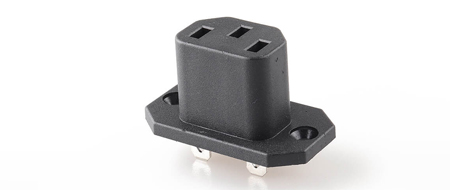 |
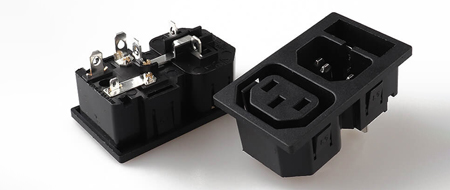 |
| LZ-F-10 Electrical 250V Plug Socket C13 Female AC Power Socket | Lanzmfg LZ-14-F18 Ganged Outlet C13 With C14 And Fuse Snap-In Type |
IEC C7 and C8
The C7/C8 is a two-prong, ungrounded connector pair often found on small or portable electronics. It’s recognisable by its figure-8 shape – hence the common name “figure-8 connector”. You’ll encounter C7/C8 in devices like DVD/Blu-ray players, game consoles, some laptop power adapters, radios, and older low-power TVs.
One side (C8) is the figure-8-shaped inlet on the device, and the matching C7 is the shape on the cord end. Because it lacks a ground pin, this connector is used on double-insulated appliances that do not require an earth ground. The C7/C8 is rated for lower currents (typically up to ~2.5 A at 250 V AC maximum) to safely power modest loads. Its slim profile and two-wire design make it ideal for compact, lightweight devices where a larger three-pin connector would be unnecessary.
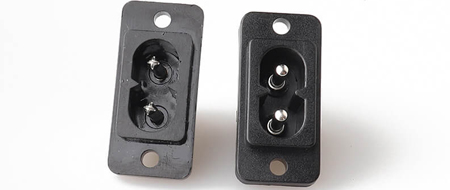 |
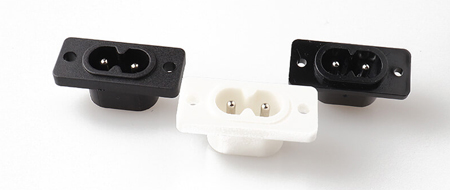 |
| LZ-8-25 Outlet C8 Power Ac Socket 2 Pin | LZ-8-7S1 Iec C8 Power Socket 250V 2 Pin Male Type Instrument Ac Power Inlet Socket |
IEC C19 (female) and C20
This connector pair is a heavy-duty version of the IEC standard. C19/C20 connectors are commonly used in enterprise and industrial settings – for example, in data center equipment like high-end servers, network switches, UPS units (uninterruptible power supplies), and power distribution units (PDUs). You may also find C19 inlets on large laboratory or medical devices and other high-power appliances.
Physically, the C19/C20 is larger and more robust than a C13/C14, with a rectangular shape and a thicker pin/blade structure to carry more current.
These connectors are generally rated for up to 16 A at 250 V AC under IEC standards (and up to 20 A in some regions like North America), providing a safe coupling for equipment that draws more power than the C13/C14 can handle.
If you look at the back of a server rack PDU or a blade server chassis, for instance, you’ll often see multiple C19/C20 inlets and cords supplying the necessary power.
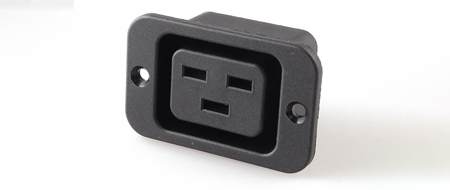 |
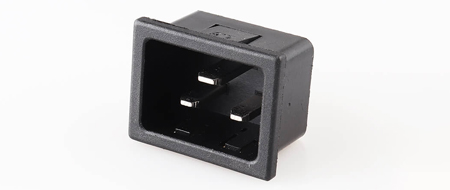 |
| LZ-19-1 AC Power Socket With Lock Screw Black Female 20A Plug | LZ-20-2 AC Male Power Socket IEC C20 16A Inlet 3pin Power Plug Stock |
Key Considerations for Choosing IEC Connectors
- Voltage and Current Rating: Ensure the connector meets the required voltage and amperage. Using an undersized connector can cause overheating or failure.
- Compatibility: Match the correct connector type with the device’s IEC inlet (e.g., C13 fits C14). Ensure it meets grounding and power rating needs.
- Durability: For industrial or outdoor use, choose rugged connectors with features like oil resistance or waterproofing.
- Certification: Check for IEC 60320 compliance and relevant certifications (e.g., UL, CSA) for safety and performance assurance.
Conclusio
IEC connector standards provide a universal solution for power connectivity across global electrical devices. By standardising connector types, ratings, and safety features, IEC simplifies design and maintenance, ensuring compatibility from household electronics to high-end data center equipment. For professionals, IEC standards streamline product design and logistics, while beginners benefit from safety and interchangeability.
Ready to implement IEC connectors in your next project? Discover our range of IEC-certified connectors and power solutions today to ensure safety, optimal performance, and global compatibility for your devices.
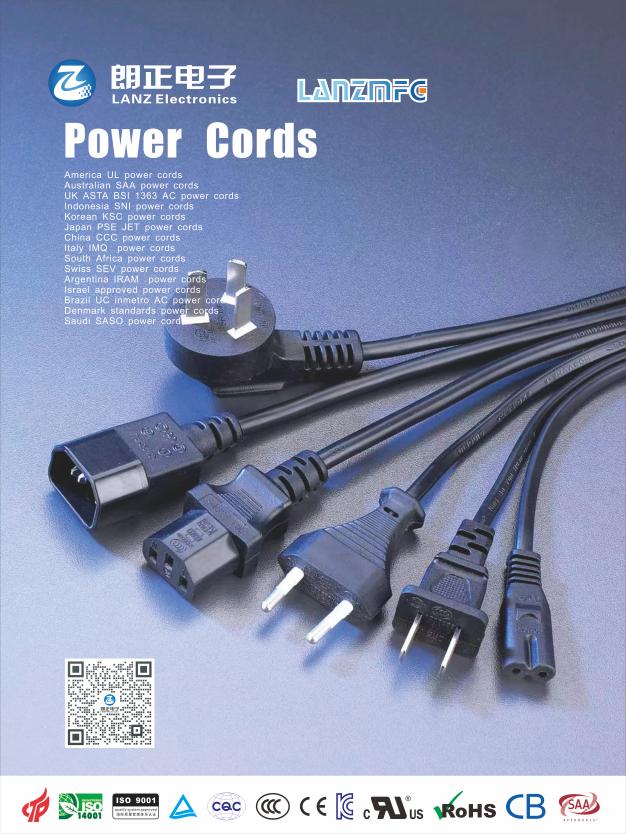
 +86 138-6870-3133
+86 138-6870-3133 sales@lanzmfg.com
sales@lanzmfg.com EN
EN CN
CN Search
Search